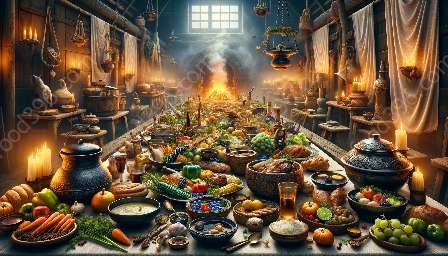Chinese cuisine is renowned for its rich history, diverse flavors, and unique cooking techniques that have been passed down through generations. From the intricate art of stir-frying to the gentle method of steaming, traditional Chinese cooking encompasses a wide range of culinary practices. In this article, we will delve into the traditional cooking techniques, explore authentic food recipes, and unravel the historical significance of Chinese cuisine.
Traditional Chinese Cooking Techniques
Chinese cooking techniques are deeply rooted in tradition and are considered essential skills that have been honed over centuries. Each cooking method aims to preserve the natural flavors, textures, and nutrients of the ingredients, resulting in harmonious and balanced dishes. Some of the prominent traditional Chinese cooking techniques include:
- Stir-Frying: Stir-frying is a popular cooking method that involves quickly cooking ingredients in a small amount of oil over high heat. This fast and dynamic technique allows for the retention of the ingredients' natural colors, flavors, and nutritional value. Common stir-fry dishes include Kung Pao Chicken, Beef with Broccoli, and Vegetable Chow Mein.
- Steaming: Steaming is a gentle and healthy cooking technique that is commonly used for preparing seafood, vegetables, and dumplings. The process involves cooking food with steam, which helps to preserve the natural taste and texture while retaining essential nutrients. Dim Sum, a popular Chinese culinary tradition, often features a variety of steamed dishes such as Shumai and Sticky Rice in Lotus Leaf.
- Braising: Braising is a cooking method that involves simmering ingredients in a flavorful liquid over low heat. This slow-cooking technique allows the flavors to meld together while tenderizing tougher cuts of meat. Classic braised dishes in Chinese cuisine include Red-Braised Pork Belly, Dongpo Pork, and Soy Sauce Chicken.
- Deep-Frying: Deep-frying is a technique that produces crispy and golden-brown textures while sealing in the flavors of the ingredients. Popular deep-fried dishes in Chinese cuisine include Sweet and Sour Chicken, Spring Rolls, and Shrimp Tempura.
- Boiling: Boiling is a simple yet fundamental cooking technique in Chinese cuisine. It is often used for preparing soups, broths, and cooking ingredients such as noodles, wontons, and rice. Chinese hot pot, a communal dining experience, exemplifies the art of boiling various ingredients in a shared flavorful broth.
Traditional Food Recipes and Cooking Methods
Traditional Chinese recipes are deeply intertwined with the country's culinary heritage, regional diversity, and seasonal ingredients. The following are iconic traditional Chinese recipes that showcase the artistry of Chinese cooking methods:
Mapo Tofu
A beloved Sichuan dish, Mapo Tofu is a flavorful and spicy stir-fry featuring tofu cubes, minced pork, and a bold combination of Sichuan peppercorns and chili bean paste.
Steamed Fish with Ginger and Scallions
This classic Cantonese dish showcases the delicate flavors of fresh fish, steamed with aromatic ginger, scallions, and a light soy sauce-based seasoning.
Braised Soy Sauce Chicken
Tender and succulent chicken pieces are slowly braised in a savory soy sauce-based mixture, creating a dish that is rich in umami flavors and aromas.
Beijing-style Peking Duck
A symbol of Chinese culinary excellence, Peking Duck is prepared using a multi-step process, resulting in crispy, lacquered skin and tender, flavorful meat.
Dim Sum Feast
Dim Sum encompasses a myriad of bite-sized delicacies such as dumplings, steamed buns, and savory pastries, reflecting the artistry of fine craftsmanship and meticulous cooking techniques.
Food Culture and History
The culinary culture and history of China play a profound role in shaping the nation's diverse gastronomy. With a history spanning thousands of years, Chinese food culture has been influenced by various dynasties, philosophies, and geographic regions. The following aspects are integral to understanding the food culture and history of China:
Embracing Regional Diversity
China’s vast and diverse landscape has given rise to a rich tapestry of regional cuisines, each with its unique flavors, ingredients, and cooking techniques. From the fiery Sichuan dishes to delicate Cantonese dim sum, the regional diversity of Chinese cuisine reflects the country's cultural and geographical nuances.
Festive Traditions and Culinary Symbolism
Chinese festivals and traditions are deeply intertwined with culinary symbolism and rituals. During the Lunar New Year, families gather to share auspicious dishes such as fish for abundance, dumplings for wealth, and nian gao for prosperity, signifying hopes for good fortune and blessings in the coming year.
Legendary Culinary Philosophies
Ancient Chinese culinary philosophies such as Yin and Yang, Five Elements, and Qi are deeply entrenched in traditional cooking practices and ingredient pairings, emphasizing the principles of balance, harmony, and holistic well-being.
Historical Culinary Legacies
Chinese culinary history is adorned with legendary tales of imperial banquets, royal cuisines, and renowned culinary masters. Historical records and ancient texts speak of the opulence and refinement of ancient Chinese dining customs, elevating culinary arts to a revered status.
Continuity of Tradition and Innovation
While embracing the richness of tradition, Chinese culinary culture also embraces innovation and adaptation to modern tastes and lifestyles. This dynamism ensures the continued evolution and relevance of traditional Chinese cooking techniques and culinary heritage.
Discover the Art of Traditional Chinese Cooking
From the vibrant flavors of regional specialties to the timeless elegance of ancient culinary traditions, traditional Chinese cooking techniques offer a captivating journey into the heart of Chinese gastronomy. Whether you are seeking to recreate authentic recipes, delve into the historical roots of Chinese cuisine, or simply savor the diverse flavors of traditional dishes, the allure of traditional Chinese cooking is an experience to be cherished and celebrated.

